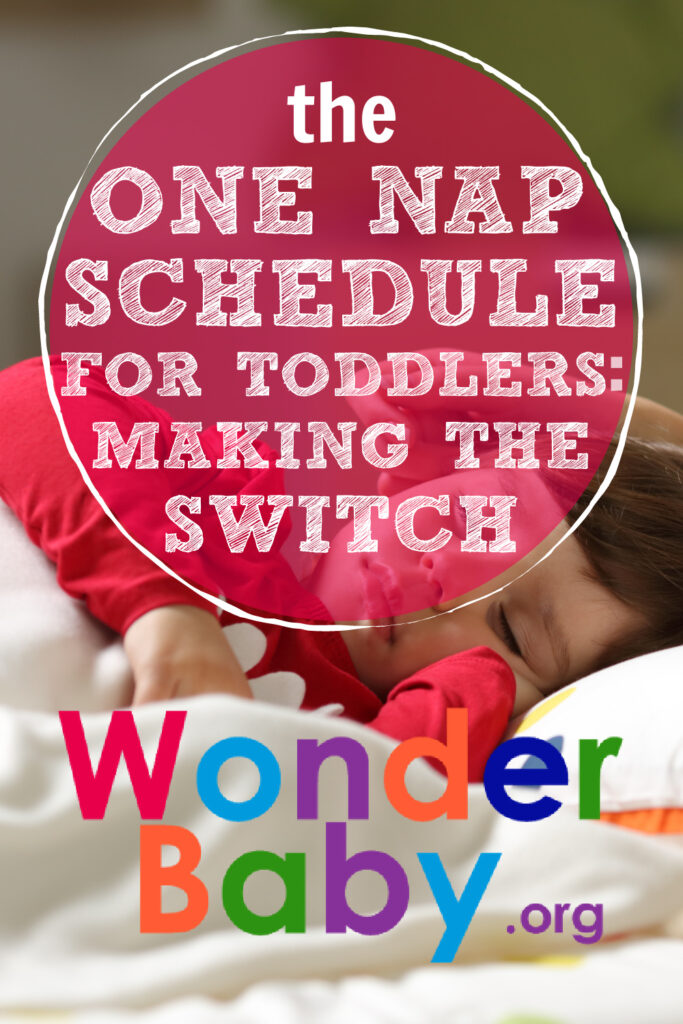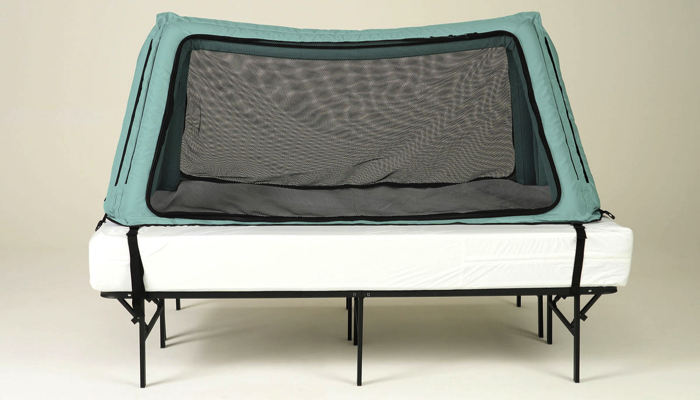The One Nap Schedule for Toddlers: Making the Switch

- The average age to drop a nap is somewhere between 14 and 18 months.
- Parents can push back their child’s first nap by 15 minutes every couple of days until it’s eliminated.
- In most cases, the child will adjust to one long nap when you switch from two naps to one.
For parents of little ones, there is one time of day we all look forward to. It’s when we can rest in the quiet of the house, watch a TV show, or eat that piece of chocolate cake all alone. This magical time of day is naptime.
Though we all love our babies, a break is needed after a busy morning of holding, chasing, and feeding. Naptime is essential for both parent and baby. For this reason, many of us cling to the two-nap schedule for as long as we can.
So what’s a parent to do when their toddler is ready to switch to just one nap? Some parents might worry that they’ll lose precious hours of freedom. Others might wonder how their child will react to the change.
Switching to one afternoon nap instead of two daytime naps doesn’t have to be difficult. I’ve found that all four of my children have transitioned easily. With a few helpful tips, your child will quickly adjust to a one-nap schedule.
The One Nap Schedule for Toddlers: Making the Switch
Are you wondering when to transition to one nap? Is your little one refusing their morning nap or taking longer to fall asleep? There are several signs that will let you know your toddler is ready to transition to one nap.
Your Toddler is Between 12 and 24 Months
The average age to drop a nap is somewhere between 14 and 18 months, but not all children follow that trend. You might find that your child switches to one nap earlier or later than other babies their age. As long as your baby is getting the adequate amount of recommended sleep, they can decide when it’s time to switch.
Parents should avoid making their children switch to one nap before they’re developmentally ready. A baby younger than 12 months of age will still need 2-3 naps a day. Switching too soon can result in an overtired baby.
Your Toddler Consistently Refuses One Nap
You’ve had your baby on a two-nap schedule for months now, but suddenly they won’t take one of their naps. What does this mean? It might be time to transition from two naps to one.
When babies refuse to take either their morning or afternoon nap for longer than two weeks, it’s time. There’s no use in trying to make your child take a nap if their body is ready to switch. You might notice they’re crankier than usual due to the change but that’s a normal part of the transition period.
One of Your Toddler’s Naps Becomes Shorter
Your child used to take a 90-minute morning nap but it’s decreased to a short morning nap of only 30 minutes. This is an indicator that your child’s body is preparing for a new nap schedule. Either the morning nap or afternoon nap can be affected.
This change isn’t usually overnight, but gradual. You might notice one nap decreasing by just 10-15 minutes at a time. The good news is that this gradual change will simplify the transition to one nap.
Your Toddler Ditches the Old Sleep Schedule
Suddenly your toddler is sleeping at abnormal times. Instead of napping right after lunch, they’re holding off until 3 pm or 4 pm. A late nap might make it difficult for them to fall asleep at night.
If your child’s nap schedule seems off, it may be time to transition. As you move away from two naps, a more normal routine should return.
Your Toddler is Waking in the Night
Your baby is now waking up in the middle of the night and staying awake for 1-2 hours. You’re exhausted and wondering what happened. It sounds like another sign your child only needs one nap.
If your child shows signs of insomnia during their night’s sleep, pay attention. Their body might be trying to compensate for too much daytime sleep. As you move away from two naps, you’ll likely see awake time during the night disappear as well.
Your Toddler Has Difficulty Falling Asleep at Night
You lay your toddler down at 8 pm just like you’ve done their entire life. However, now they spend an hour tossing, turning, talking, and playing before falling asleep. This might be due to too much daytime sleep or napping too late in the day.
One great advantage of dropping the first or second nap is improved nighttime sleep. Many parents notice that their toddlers fall asleep faster with just one nap.

Helpful Tips for Making the Transition
Over the years I’ve learned that, though the nap transition can be rocky, there are ways to help. If you notice your child is crankier than usual or resisting the change, try these tips:
- Introduce a lovey to help them self-soothe.
- Keep them busy and distracted during the naptime from their old sleep schedule.
- Push back their first nap by 15 minutes every couple of days until you can eliminate it.
- Introduce an earlier bedtime (especially when they are still adjusting to one long nap—they might be extra cranky during this time).
What Time Should Toddlers Take Their One Nap?
You’ve noticed the signs that your child is ready to switch. Great! Now let’s look at the details of this new sleep schedule to ensure the transition is smooth.
Knowing how to transition will help your baby get enough sleep during the day. Every parent knows sleep is crucial for a happy baby.
What is the best nap time for toddlers?
Sleep routines will vary, but you should avoid letting your baby sleep too late in the day. A late afternoon nap will likely disturb their night sleep. They’ll likely be too energized to fall asleep.
A good afternoon nap window is somewhere between 12 and 4 pm. If your child keeps the morning nap instead, you might aim for somewhere between 10 am and 12 pm. Just be aware that a morning nap instead of an afternoon nap will require an earlier bedtime.
Which naptime should toddlers drop?
With two naps, you might be wondering if there’s a right or wrong nap to drop. Often, your baby will let you know which one they prefer to skip. You might notice one nap decreasing while the other increases.
Parents can follow their child’s lead and either keep a morning or afternoon nap time. If the nap your baby prefers doesn’t work for your schedule, you can move them toward the other nap time. I’ve successfully transitioned all my children to one afternoon nap, as that works better for our daily schedule.
If your child is hesitant to accept the new nap schedule, you can try sleep training for naps to help them adjust.
How Long Should a Toddler’s One Nap Schedule Be?
When making the nap transition, parents might be concerned that their children won’t get enough sleep. In most cases, children will adjust to one long nap when they switch from two naps to one. For example, you might notice your child’s afternoon nap becomes 2-3 hours rather than 90 mins.
Parents should focus on the total hours of sleep needed daily when creating a toddler sleep schedule. Knowing how much sleep is recommended for your child’s age will allow you to create a schedule that fits their needs.
How many hours should toddlers sleep in their one nap schedule?
The American Academy of Pediatrics recommends the following hours of sleep for each age group:
- 4-12 months: 12-16 total hours of sleep (naps included)
- 1-2 years: 11-14 total hours of sleep (naps included)
- 3-5 years: 10-13 total hours of sleep (naps included)
Pay attention to how long your child sleeps at night. They’ll need to make up the other hours during their daytime sleep schedule. A 1-year-old, for example, will need 2-3 total daytime sleep hours and 8-11 hours of sleep at night.
Solid daytime nap schedules are crucial for a better night’s sleep. I noticed that when my children refused their daytime naps, they always slept worse at night.
Sleep training your toddler may be necessary if you have a little one who fights sleep at night despite adequate daytime naps. Sleep training often helps break unhealthy sleep habits and creates a healthier routine that ensures adequate sleep.

What Should a Toddler’s One Nap Schedule Look Like?
Nap schedules for toddlers should include one long nap during the day and a full night’s sleep. The nap should be somewhere in the middle of their daily awake time. An early riser will likely nap earlier in the day than a child who sleeps in.
What time should a toddler go to sleep at night?
The Centers for Disease Control is clear on its stance on sleep—sleep matters. In fact, they’ve concluded that adequate sleep in children can prevent type 2 diabetes, obesity, poor mental health, injuries, and attention or behavior problems. These reasons alone make an early bedtime for toddlers of high importance.
The time your child goes to sleep will depend on your family’s schedule and your child’s nap routine. Children ages 1-3 often go to bed somewhere between 6 to 9 pm. Think about what time your child wakes up to calculate their ideal bedtime.
Sample One Nap Schedule for Toddlers
Let’s put all this information to practice in a sample nap schedule for toddlers with only one nap a day. Let’s start with a child who wakes up around 6 am.
Early Riser Nap Schedule for 1 Year Old
| Wake | 6 a.m. |
| Lunch | 10:30 a.m. |
| Nap | 11 a.m.-1 p.m. |
| Dinner | 5 p.m. |
| Bath or Bedtime Routine | 5:30-6 p.m. |
| Bedtime | 6-7 p.m. |
This sample schedule provides plenty of room to meet the child’s sleep needs. Since this child wakes up early, their nap and bedtime will follow the same trend.
Late Riser Nap Schedule for a 2-year-old
| Wake | 8 a.m. |
| Lunch | 12 p.m. |
| Nap | 1-3 p.m. |
| Dinner | 6:30 p.m. |
| Bath or Bedtime Routine | 7:30-8 p.m. |
| Bedtime | 8-9 p.m. |
With this schedule, the child is able to get around 13-14 hours of sleep. You’ll notice the later wake time leads to a later nap and bedtime.
FAQs
Should toddlers go to bed early if they miss naptime?
If your toddler misses a nap occasionally, it’s okay to adjust bedtime earlier. Just be prepared for some bedtime tantrums from your overtired child. Try and keep the atmosphere calm and their routine consistent to help them settle down.
However, you’ll want to avoid missing naps regularly. A consistent nap routine is key to healthy growth and behavior.

Related Posts

Sleep, Special Needs
Safe Place Bedding Travel Bed Review
Traveling with a special needs child can be stressful! Having a safe, durable, and easy to use travel bed can make traveling so much easier!

Sleep, Special Needs
Sleep Regimen for Premature Babies: Special Considerations
It can take premature babies much longer than their full-term peers to sleep for long stretches. A preemie sleep schedule may encourage better sleep.

Sleep
Mastering the Bedtime Routine: 3 Tips for a Peaceful Night’s Sleep
From around six weeks, a newborn bedtime routine can help your baby learn the difference between day and night and prepare for a restful night’s sleep.